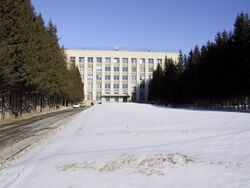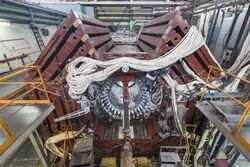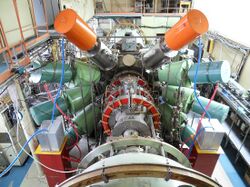Budker Institute of Nuclear Physics
Topic: Organization
 From HandWiki - Reading time: 3 min
From HandWiki - Reading time: 3 min
 | |
 Budker Institute of Nuclear Physics (BINP) Budker Institute of Nuclear Physics (BINP) | |
| Formation | 1959 |
|---|---|
| Type | Learned society |
| Headquarters | Academician Lavrentyev Avenue, Novosibirsk, Akademgorodok, Novosibirsk Oblast, Russia |
| Location |
|
| Coordinates | [ ⚑ ] : 54°50′56″N 83°06′40″E / 54.84875°N 83.11102°E |
Membership | 3,000 |
Official language | Russian |
Director | Pavel V. Logatchov |
| Website | inp |
The Budker Institute of Nuclear Physics (BINP) is one of the major centres of advanced study of nuclear physics in Russia. It is located in the Siberian town Akademgorodok, on Academician Lavrentiev Avenue. The institute was founded by Gersh Budker in 1959. Following his death in 1977, the institute was renamed in honour of Budker.
Despite its name, the centre was not involved either with military atomic science or nuclear reactors— instead, its concentration was on high-energy physics (particularly plasma physics) and particle physics. In 1961 the institute began building VEP-1,[1][2] the first particle accelerator in the Soviet Union which collided two beams of particles, just a few months after the ADA collider became operational at the Frascati National Laboratories in Italy in February 1961.[3] The BINP employs over 3000 people, and hosts research groups and facilities.
Active facilities
- VEPP-4 – e+e− collider for the energy range 2Ebeam up to 12 GeV
- KEDR – detector for particle physics at VEPP-4
- ROKK-1 – facility for experiments with high energy polarized gamma-ray beams at VEPP-4
- VEPP-2000 – e+e− collider for the energy range 2Ebeam=0.4-2.0 GeV
- SND - Spherical Neutral Detector for particle physics experiments at VEPP-2000
- CMD-3 – Creogenic Magnetic Detector for particle physics experiments at VEPP-2000
- Electron cooling experiments
- Plasma physics experiments
- GOL3 – long open plasma trap
- GDL - gas-dynamic plasma trap
- Siberian Synchrotron Radiation Centre
- NovoFEL – Novosibirsk Free Electron Laser based on 4-turn ERL
- BNCT – accelerator-based neutron source for boron neutron capture cancer therapy experiments
Participation in international projects
From 1993 to 2001, BINP contributed toward the construction of CERN's Large Hadron Collider, providing equipment including beamline magnets.[4][5]
Directors of the Institute
- Gersh Budker (1959–1977)
- Alexander N. Skrinsky (1977–2015)
- Pavel V. Logatchov (2015–)
List of Scientists associated with this institute
See also
- List of accelerators in particle physics
- List of synchrotron radiation facilities
- Particle detector
- Gas Dynamic Trap
- Institute for Theoretical and Experimental Physics, another Russian particle physics laboratory in the vicinity of Moscow; located in Moscow proper
- Institute for High Energy Physics, another Russian particle physics laboratory in the vicinity of Moscow; located south of Moscow
- Joint Institute for Nuclear Research, international particle physics laboratory in the vicinity of Moscow; located north of Moscow
References
- ↑ A. N. Skrinsly, "Accelerator field development at Novosibirsk (history, status, prospects)", Particle Accelerator Conference, Proceedings of the 1995.
- ↑ V. N. Baier, "Forty years of acting electron-positron colliders", arXiv:hep-ph/0611201 (PDF | PS).
- ↑ Carlo Bernardini, "AdA: The First Electron-Positron Collider ".
- ↑ "Last LHC magnets from Siberia reach CERN". CERN Courier. 28 August 2001. http://cerncourier.com/cws/article/cern/28479.
- ↑ K.V. Zolotarev; A.M. Batrakov; S.V. Khruschev; G.N. Kulipanov; V.H. Lev; N.A. Mezentsev; E.G. Miginsky; V.A. Shkaruba et al. (2004). "High Magnetic Field Superconducting Magnets Fabricated in Budker INP for SR Generation". Proceedings of RuPAC XIX (Dubna, Russia). http://accelconf.web.cern.ch/accelconf/r04/papers/thfi01.pdf.
External links
 |
 KSF
KSF

